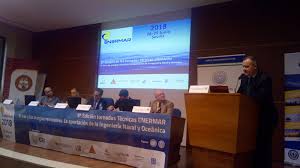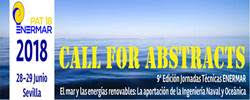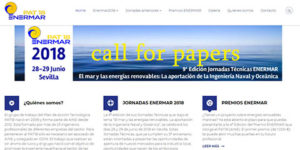
Spain – Lundi 02/07/2018 – energiesdelamer.eu – PAT18, the Spanish Association of Naval Architects and Marine Engineers’ working group on Marine Renewables (ENERMAR) closed the 9th Edition of its annual Technical Sessions in Seville, Spain, on 29 June.
energiesdelamer.eu was pleased to have been a media partner of PAT18 ENERMAR. Below is a summary of what transpired during PAT18, as provided by Juan Moya Garcia, the President of PAT18 ENERMAR.
Copies of many of the interesting PAT18 working papers will in the near future be put online. energiesdelamer.eu will send to its subscribers the link once available.
During the two-day meeting, more than 60 professionals coming from industry, certification bodies, technical offices, designers, shipyards, universities environmental organizations and officials involved in the close relationship of renewable energies and marine & maritime sectors listen to and discussed with the 18 speakers and participated in 5 round-tables spanning all the aspects of this exciting new industry.
The discussions included new concepts of floating offshore wind, already installed tidal devices and pre-commercial projects and even their decommissioning phase.
First day involved two panels made up of three speeches each.
One panels addressed new concepts of floating wind and opportunities of synergies with other energy converters.
The second panel presented current Spanish companies designing and manufacturing fixed offshore wind substructures.
Finally, closing the morning session, before leaving towards Cádiz, designers, regional and national administrations, conservationist organizations and developers sat down together and discussed on the challenges, risks and opportunities of the Marine Renewables along the Andalusian coasts.
At the Puerto Real shipyard, the participants visited Iberdrola’s East Anglia One offshore wind farm’s OSS (both top and jacket), ready to sail to the site off UK shores. Beforehand, the project manager made explained how the electrical substation and structure were planned and executed.
The second day started with a panel on the maintenance of the marine plants, a key factor on their profitability and final LCOE. Several new maintenance strategies and approaches as well as a patent of an access to platforms were presented.
The fourth panel addressed “hidden” aspects of the business (although of paramount relevance): certification, installation and decommissioning.
A stunning fact disclosed here was the significant size of the decommissioning business (in a not-so-distant future….).
The fifth panel introduced wave, current and tidal devices already in prototype phase. Two of them are Spanish and one is French.
Finally, the Conference came to its end with the panel dedicated to upcoming Floating Offshore Wind solutions, in different phases oftheir TRL ascent path: From lab tests to full size prototypes.
The 18 speakers came from Spain, France, Belgium and the UK.
PAT18 made a special effort to include all the papers received and accepted, but it was physically impossible to include more than 18 speechesin only two days. The papers which were not orally presented were made available.
Below, panels and speakers.
PANEL 1: New offshore hybrid technologies
Hybrid Platforms – A new breed.
Antonio Luis García . Independent Consultant
First step on the study of a renewable energy hybrid platform.
María José Legaz, Universidad de Cádiz & Javier Fernández, Enerocean.
Blackbird: Hybrid CAES Storage Mono-TLP VAWT WEC.
Christopher Golightly. Geotechnical and Engineering Geology Consultant.
PANEL 2: Marine structures
Engineering, procurement and construction of offshore converter platforms.
Rafael García. Dragados Offshore.
Optimization of metallic structures for wind power sector.
Rodrigo Gallardo. GRI.
Application of concrete caisson-based solutions for the offshore wind market.
José Landete, Javier Abanades & Carlos García. TYPSA.
ROUND TABLE
Installation and exploitation of offshore wind farms: Prospects in Andalucía.
José Juan Alonso. Universidad de Cádiz.
Francisco Ruiz. MAGTEL.
Jorge Juan Jiménez. Agencia Andaluza de la Energía
Antonio Jara . Ministerio de Industria, Comercio y Turismo.
Jesús Pinilla. SEO Birdlife.
GUIDED VISIT TO PUERTO REAL SHIPYARD
Visit to the Navantia Shipyard Puerto Real Museum.
Presentation of Iberdrola’s East Anglia One (UK) offshore wind farm’s SE.
Visit to the EA One’s OSS and jacket.
PANEL 3: O&M activities
Risk-based maintenance of offshore wind substructures.
Pablo G. Morato. University of Liège, Belgium.
Active Maintenance Scheduling Support Based on Mesoscale Day-ahead Power Forecasts for Large Offshore Wind Farms.
Carlos Galindo Lloyd’s Register.
Marine Energies’ Floating Devices’ Access Systems (SAFE).
Álvaro Rodríguez. CTC.
PANEL 4: The “before”, the “throughout” and the “after” of an offshore wind farm
The task of certification of an offshore wind project and the classification of their auxiliary vessels.
Jaime Pancorbo & Javier González. Bureau Veritas.
Swirl project. Modular oceanic platform and advanced multifunctional systems for offshore operations.
Igor Blanco. Ghenova.
Sustainable decommissioning of an off shore wind farm.
Eva Topham. DNV-GL.
PANEL 5: Wave and tidal technology
SEA-TITAN Power Take-Off.G. Lorenzo, A. S. Nieto. Wedge Global.
Sea currents energy converter platform. Alberto Sisí. Sea Master.
Harnessing tidal stream power – Ride the tide. Marlène Moutel. Sabella
Points de repère
14/06/2018 – Le projet SEA-TITAN propose de changer radicalement le secteur de l’énergie houlomotrice en concevant, construisant, testant et validant une solution de prise de force à entraînement direct (PTO) transversale et innovante à utiliser avec plusieurs types de convertisseurs d’énergie houlomotrice.
Contact : PAT18 ENERMAR
Publicités Google :





